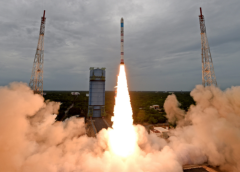
Explainer: Isro’s SSLV – What, why and journey so far | India News
[ad_1]
The Indian Space Research Organisation (Isro), whose maiden launch attempt of the small satellite launch vehicle (SSLV) did not manage to put the satellites into their desired orbit on Sunday, has the thinking cap back on, rectifying errors before the second developmental flight of the new rocket planned for later this year.
As Isro works out the modalities, TOI does a deep dive into SSLV, the newest launch vehicle designed and developed by Isro.
What’s SSLV
The Small Satellite Launch Vehicle (SSLV) is a three-stage launch vehicle configured with three solid propulsion stages and liquid propulsion-based Velocity Trimming Module (VTM) as a terminal stage.
Weighing around 110 tonne, SSLV is a 34-metres tall, 2-metre diametre (width) launch vehicle having a lift-off mass of around 120-tonne.
Why Isro Built It
Isro developed the SSLV to cater the launch of up to 500kg satellites to Low Earth Orbits (LEO) on ‘launch-on-demand’ basis. It was to help Isro carve a niche in a multi-billion dollar
That is a low cost rocket with low turn-around time, flexibility in accommodating multiple satellites, launch on demand feasibility needing minimal launch infrastructure requirements, means SSLV provides low-cost access to space.
This will help India gain advantage in a growing launch services market, especially at a time when multiple new countries and the private sector from developed nations are seeking access to space.
What Are Its Features
SSLV is configured with three solid stages — 87 tonne; 7.7 tonne and 4.5 tonne — while satellite insertion into the intended orbit is achieved through a liquid propulsion-based velocity trimming module (VTM), which is the terminal stage.
All three solid stages use heterogeneous propellant based thrusters. The first has a thrust of 2,496kN thruster, second: 234.2 kN and third 160kN. The VTM is based on 50N bipropellant thrusters with eight 50N thrusters for RCS (roll, pitch and yaw) and eight 50N axial thrusters of velocity addition.
The rocket is capable of launching mini, micro, or nanosatellites (10 to 500kg) to a 500km planar orbit.
First (Aug 7) Mission
After years of development, the first developmental flight of SSLV — the SSLV-D1 which was to carry a micro remote sensing satellite (EOS-02) and another satellite — was scheduled for August 7, 2022 at 9.18am from the first launch pad of Satish Dhawan Space CentreSriharikota.
The SSLV-D1 mission was to launch EOS-02, a 135 kg satellite into LEO of about 350km to the equator, at an inclination of about 37 degrees. EOS-02 is an earth observation satellite designed and realised by Isro. The microsat series satellite offered advanced optical remote sensing operating in infra-red band with high spatial resolution.
The other satellite — AzaadiSAT — was a “8U Cubesat weighing around 8kg” and carrying 75 different payloads each weighing around 50 grams and conducting femto-experiments. Girl students from rural regions across the country were provided guidance to build these payloads.
However, the SSLV-D1 failed to place the satellites into the desired orbit due to an anomaly.
As Isro works out the modalities, TOI does a deep dive into SSLV, the newest launch vehicle designed and developed by Isro.
What’s SSLV
The Small Satellite Launch Vehicle (SSLV) is a three-stage launch vehicle configured with three solid propulsion stages and liquid propulsion-based Velocity Trimming Module (VTM) as a terminal stage.
Weighing around 110 tonne, SSLV is a 34-metres tall, 2-metre diametre (width) launch vehicle having a lift-off mass of around 120-tonne.
Why Isro Built It
Isro developed the SSLV to cater the launch of up to 500kg satellites to Low Earth Orbits (LEO) on ‘launch-on-demand’ basis. It was to help Isro carve a niche in a multi-billion dollar
That is a low cost rocket with low turn-around time, flexibility in accommodating multiple satellites, launch on demand feasibility needing minimal launch infrastructure requirements, means SSLV provides low-cost access to space.
This will help India gain advantage in a growing launch services market, especially at a time when multiple new countries and the private sector from developed nations are seeking access to space.
What Are Its Features
SSLV is configured with three solid stages — 87 tonne; 7.7 tonne and 4.5 tonne — while satellite insertion into the intended orbit is achieved through a liquid propulsion-based velocity trimming module (VTM), which is the terminal stage.
All three solid stages use heterogeneous propellant based thrusters. The first has a thrust of 2,496kN thruster, second: 234.2 kN and third 160kN. The VTM is based on 50N bipropellant thrusters with eight 50N thrusters for RCS (roll, pitch and yaw) and eight 50N axial thrusters of velocity addition.
The rocket is capable of launching mini, micro, or nanosatellites (10 to 500kg) to a 500km planar orbit.
First (Aug 7) Mission
After years of development, the first developmental flight of SSLV — the SSLV-D1 which was to carry a micro remote sensing satellite (EOS-02) and another satellite — was scheduled for August 7, 2022 at 9.18am from the first launch pad of Satish Dhawan Space CentreSriharikota.
The SSLV-D1 mission was to launch EOS-02, a 135 kg satellite into LEO of about 350km to the equator, at an inclination of about 37 degrees. EOS-02 is an earth observation satellite designed and realised by Isro. The microsat series satellite offered advanced optical remote sensing operating in infra-red band with high spatial resolution.
The other satellite — AzaadiSAT — was a “8U Cubesat weighing around 8kg” and carrying 75 different payloads each weighing around 50 grams and conducting femto-experiments. Girl students from rural regions across the country were provided guidance to build these payloads.
However, the SSLV-D1 failed to place the satellites into the desired orbit due to an anomaly.
[ad_2]
Source link


